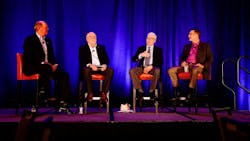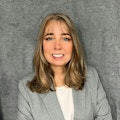This year’s T&D World Live Conference and Exhibition kicked off early Tuesday morning, Sept. 23, with a panel energy’s policy impacts customers — an “energizing” way to start the day. I always appreciate these conversations at utility conferences. The professionals who tackle policy issues tend to do so with a level of tact and thoughtfulness that’s refreshing. In other words: utility panels are not social media.
This industry is filled with people tackling some different challenges and some of the same challenges: regional constraints, regulatory pressures, and varying stages on the path toward sustainability, resiliency, and security. Yet time and again, I see them come together to share ideas, learn from one another, and push the industry forward. I always leave these events optimistic about where we’re headed, because electric utilities, regulators, engineers, and technology providers alike continue to prove they’re among the most innovative, capable, and forward-thinking professionals out there.
Mike Beehler, regular contributor for T&D World and national spokesperson for Power Delivery Intelligence Initiative, lead the opening session on policy, asking some pointed questions of Larry Bekkedahl of Portland General Electric; Robert Kondziolka, chair of CAISO Western Energy Markets; and Brian Cole, VP of Resource Management with Arizona Public Service, the host utility.
One of Kondziolka’s remarks reflected the consensus of the panel: “One thing we can say for certain is that we do not have certainty.” He pointed out that NERC’s most recent Reliabilities Risk Report added a new risk priority: “volatile” energy policy.
APS’ Cole brought a refreshing perspective, discussing how his utility leverages that energy policy pendulum to ensure a diversity of generation to meet the increasing demand. “The policy matters a lot in your decisions that you're making in the very short term,” he said. “But we have to think about it for a longer perspective. In one policy administration we brought on and have contracted for 10,000 plus MW of … mostly solar, wind, and battery. The good thing is we took advantage of policy that existed in that timeframe. Now the pendulum has swung, and it actually works out pretty well because I need to balance my resources out.” Now APS is looking at keeping coal for a bit and using natural gas as that bridge to cleaner energy. And of course, APS has nuclear and as many utilities are, considering what that looks like in the future.
Bekkedahl shared a personal perspective, noting that energy policies have shaped his own career — from Montana Power’s restructuring in the 1990s to the deployment of phasor measurement units (PMUs) and battery storage under the American Recovery and Reinvestment Act (ARRA). “We found out there were 14 different ancillary services we could do with a battery,” he said, illustrating how policy shifts often open new technical possibilities.
Bekkedahl emphasized that utilities face major policy changes every few years while still needing to operate reliably every day. “We’re trying to operate a grid every day, thinking about what’s the best way to use the tools that we have to keep it as efficient and affordable as possible,” he said. He added that decision-making around policy can be highly political, and that regulators must navigate information from multiple sources — utilities, universities, national labs, and the Department of Energy — to craft effective frameworks.
The conversations around policy impacts and customers continued throughout the conference, Tony Tewelis, APS’s senior vice president of transmission and distribution, opened the second day’s first general sessions by outlining utilities’ top five challenges: load growth, data centers, strategic transmission, wildfire mitigation, supply chain, and customer affordability. As far as customers go, Tewelis said that APS has shifted its internal focus from financial performance to customer experience — viewing reliability, resilience, and affordability through the customer’s eyes.
Managing Editor Jeff Postelwait and I had the privilege of chairing a few of the breakout sessions; they were all very much utility-led this year, following our “for utilities, by utilities” philosophy.
Georgia Power’s Roger Ely presented a fascinating case study on continuous thermal monitoring of substations, complete with powerful thermal imaging and analytics. (Keep an eye out—he’s preparing an article for T&D World soon.)
Another session featured Duke Energy’s Andrew Adidoost discussed the utility’s OT cybersecurity program. Cybersecurity remains a sensitive topic for many utilities, but Adidoost demonstrated how open conversations about operational resilience can benefit the entire sector.
Next year, T&D World Live heads to Orlando, the week before Labor Day, which would be a great time to connect with Southeast utilities and, perhaps, tack on a bit of vacation time. The call for speakers will open in January, and as always, we’re especially interested in hearing utility-led stories and practical, experience-based insights.
If there’s one takeaway from this year, it’s that the industry isn’t just reacting to change any longer — it’s leading it. The themes of resilience, security, and affordability are no longer just discussion points; they’re the pillars guiding how utilities plan, operate, and serve their customers.
And as this year’s T&D World Live made clear, the path forward will be built the same way this event is—collaboratively, by utilities, for utilities.
Note: Jeff and I got together to share our perspectives on the event on our T&D World Live podcast at https://www.tdworld.com/podcasts.
About the Author
Nikki Chandler
Group Editorial Director, Energy
Nikki is Group Editorial Director of the Endeavor Business Media Energy group that includes T&D World, EnergyTech and Microgrid Knowledge media brands. She has 29 years of experience as an award-winning business-to-business editor, with 24 years of it covering the electric utility industry. She started out as an editorial intern with T&D World while finishing her degree, then joined Mobile Radio Technology and RF Design magazines. She returned to T&D World as an online editor in 2002. She has contributed to several publications over the past 25 years, including Waste Age, Wireless Review, Power Electronics Technology, and Arkansas Times. She graduated Phi Beta Kappa with a B.S. in journalism from the University of Kansas.

